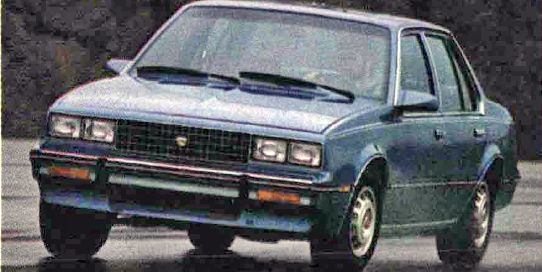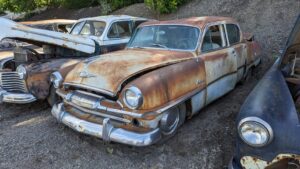From the Archive: 1982 Cadillac Cimarron Road Test

From the August 1981 issue of Car and Driver.
America, in all its years of absorbing fat-cat de Villes and Fleetwoods, has never before been confronted with a Cadillac anything like the new Cimarron. You can forget everything you know about the softly lined cruisers of the past—the Cimarron pays no homage to Cadillac tradition. The new Cimarron is not the size of a battleship. It does not coddle you like a mother’s arms. In fact, your average Eldorado owner wouldn’t recognize it as a Cadillac if he backed into one.
As you can well see, the Cimarron looks like anything except what it is—a Toyota, a BMW, or a Chevy maybe, but not a Cadillac. And in this case, appearances aren’t in the least deceiving. The 1982 Cimarron represents nothing less than an about-face in Cadillac marketing philosophy—one of the boldest moves ever made by a car company.
Cadillac, friends, is now in the small-car business. Along with the standard array of decadent behemoths, Caddy dealers are now selling a car that’s barely an inch longer than a Honda Accord four-door sedan—which is to say, very compact indeed.
Cool 80s Cars and Best-Sellers From the Past
But the plot thickens. The only thing more surprising than the new Cadillac’s diminutive dimensions is its personality. The Cimarron’s standard gearbox, for instance, is a four-speed manual unit. The cleanly styled instrument cluster houses a full set of gauges, including a tachometer. The suspension is tuned for handling as much as for ride. And if we are to believe Cimarron advertising, which is targeted at the same people who buy BMWs, Audis, and Volvos, Cadillac thinks it’s building some kind of sports sedan. The next thing we know, Ronald Reagan will turn into a knee-jerk liberal.
The sudden upheaval in Cadillac-think stems from two sources. Cadillac desperately needed a small car to stem the tide of buyers defecting to smaller, more fuel-efficient makes. The decision to try to build a driver’s car rather than a pint-sized Seville arose from a desire to capture the affluent, upwardly mobile buyers who had been shelling out for expensive, high-quality sedans like the Audi 4000 and the BMW 320i—a group Cadillac doubted it could ever lure into the fold with its lineup of plushmobiles.
A design with the potential to meet these lofty marketing goals, Cadillac found, was already under development at GM under the code name “J-car.” (The J-cars, as you no doubt know, debuted last spring as the Pontiac J2000 and Chevrolet Cavalier, GM’s smallest front-drive sedans to date.) On paper, the J-car’s transverse-engine, front-drive, high-efficiency design was representative of the latest in small-car thinking, and its 101.2-inch wheelbase and 173-inch length slotted it smack in the middle of the BMW 320i-Audi 4000-Honda Accord class.
What was left for Cadillac to do was to hone the basic platform to world-class status. Making a Bimmer-baiter out of what started life as a Chevrolet is no small feat, but it’s still within the realm of possibility. Sedan de Villes, after all, look and feel quite a bit different from Impalas, but share numerous mechanical pieces.
Since Cadillac latched onto the project only a year before production—which is well into the eleventh hour in the car business—the Cimarron shares a far greater than normal number of parts with its Pontiac and Chevrolet siblings. Truth be known, the designers and engineers had only enough time to rearrange the front and rear sheetmetal, redo the interior trim, retune the suspension, and fiddle with the standard-equipment list. If you look closely, you might notice that the Cimarron, which is available only as a four-door sedan, shares its roof, doors, fenders, and hood with the Cavalier.
Though the Cimarron bears a close kinship to other J-cars, we can say that the revisions Cadillac has made were all aimed in precisely the right direction. In fact, considering the division that’s producing the Cimarron, it’s a revelation.
The restyling Cadillac did, for instance, couldn’t have been more apropos. The Cimarron looks like the clean break with the past that it is. The typical-for-Cadillac bow-shaped hood and massive grille have given way to a front-end treatment that looks like that of an Impala (which itself started looking like a Cadillac a few years back). The tail is neat and simple. The standard tires are chunky blackwall Goodyear P195/70R-13s mounted on 5.5-inch-wide alloy wheels—also standard. Chrome is used sparingly. And, wonder of wonders, there’s not even a stand-up hood ornament to spoil the effect.
When you pull open a door you find more of the same inside. The interior styling is conservative to the point of being nondescript. All Cimarron seats are covered with handsome perforated leather. The door panels repeat the pleated theme with some of the world’s best vinyl. There are map pockets in the front doors and more map pockets behind the front seats—which recline, as do all J-car front seats.
The dash is standard J-car fare, with the exception of a new flat-aluminum-look facing. Full instrumentation is standard, including gauges for oil pressure, water temperature, fuel level, volt level, and a pair of large round dials for the tachometer and speedo. The skinny three-spoke steering wheel looks a bit dated now that the thick-grip look is in, but it is at least wrapped in leather. And there’s not a square inch of fake wood in sight. The interior designer gets a gold star for restraint.
The Cimarron’s admission price is a hefty $12,131. But for that sum, you get a fully equipped car, which is in keeping with the basic J-car policy. Along with the leather interior, the standard-equipment list includes such things as power steering, power brakes, air conditioning, a four-speaker AM/FM-stereo radio, electric mirrors, a digital clock, grab handles above the doors, a rear-seat center armrest, a center console with a coin tray, intermittent wipers, and lights for the trunk and the engine compartment. You can add more, of course, although many of the full-sized Caddy’s labor-savers—like the automatic headlight dimmer—aren’t available.
We’re also happy to report that the Cimarron appears to be put together with more care than we’ve seen in most American cars until now. We managed to score a pair of early-production Cimarrons for this test—numbers five and fifteen, to be exact. We found their paintwork good (unlike our photo car, a pre-production prototype), the fit of the doors snug, and the body panels and trim lined up just so. In the cabin, everything was battened down tightly as well. The body structure was rock solid. The overall feeling around these parts is that the Cimarron doesn’t have quite the tight-fitting look of an Audi 4000, but it isn’t far off, either—and that’s saying something.
When you’re keeping company with BMW and Audi, a high level of fit and finish is expected. So are first-class road manners, and Cadillac didn’t neglect its duties on that front either.
The Cimarron’s suspension—which consists of MacPherson struts and an anti-roll bar up front, with a pair of trailing arms connected by a transverse member, coil springs, and an anti-sway bar bringing up the rear—benefits from exclusive calibrations aimed at optimizing ride without hurting handling. To ease the Cimarron over bumps, the engineers specified the soft springs from the base-level Cavalier. Body roll is held in check with the thick anti-roll bars used on the Pontiac J2000 handling package, and Cadillac worked out its own special shock-absorber valving. The most important part of the package is a new set of rear-suspension trailing-arm bushings designed to be soft in the fore-and-aft direction to soak up pavement imperfections, but stiff laterally to provide quick response in directional changes.
Engineering talk is all well and good, but when it comes to drivers’ cars there’s only one acid test. So we rounded up four of the Cimarron’s world-class competitors—the Audi 4000 4E, the BMW 320i, the Honda Accord SE, and the Volvo GL—for a day-long drive-off to see just where it stands.
In the past, Cadillacs have been engineered to float you along the boulevard as if it were paved with clouds. About two blocks is all it takes to see that the Cimarron is a complete departure from the easy riders of yore. For the first time in a Cadillac of recent vintage, you can actually feel there’s a road down there. In fact, the ride is actually quite firm, about like the BMW’s.
On smooth roads and on the highway, though, the Cimarron proved to be almost silky—and about the best of the group. At least part of this is acoustical. Thanks to the J-car’s inherently good noise isolation, you simply don’t hear very much road rumble or tire hum. Some credit also goes to the Goodyear radials, which are ground on tire-truing machines after they pop out of the molding ovens to ensure the best possible ride.
On the twists and turns of our country-road test loop, the Cimarron showed it could cut and run almost as well as Europe’s best. In most situations the tires stay planted securely and allow you to make good use of the 0.73-g cornering potential—which is well into BMW territory. The steering is quick, and the tail tracks respectfully behind when you dive for an apex or whip around your favorite cloverleaf.
About the only time the suspension falls down on the job is when the road gets rocky. Over badly broken macadam, which the foreign competition shrugs off, the Cimarron’s front end gets jumpy—not badly so, mind you, but enough to keep the Cimarron from feeling as confidence-inspiring as, say, the Audi.
This last point is indicative of what our comparo drive revealed about the Cimarron: It just doesn’t feel as good to drive as the cars it’s pitted against. The Cimarron’s power steering, for instance, feels numb when compared with the Volvo’s superb system. And all of the Cimarron’s pedals act just slightly out of sync.
It’s much the same with the drivetrain, which consists of the standard J-car 1.8-liter, 85-hp four-cylinder engine mated to a four-speed manual transmission. (A three-speed automatic is optional.) The Volvo, Audi, and Honda four-cylinder powerplants whir like sewing-machine motors when you press them, but the Cimarron thrashes in the upper rev ranges—though it doesn’t assault your ears nearly as badly as the BMW. And though the Cadillac’s 13.7-second 0-to-60 time is a match for the Honda’s, and within a tick of the Audi’s, the wide ratios in the gearbox keep the Cimarron feeling flatfooted.
If the Cimarron isn’t exactly a BMW-killer, it’s still solidly competitive elsewhere. For one thing, it’s very roomy for a car so small. GM has hollowed out an impressively large cabin, big enough to seat four adults comfortably. The seats, front and rear, are commendably supportive for long-distance touring (though the front buckets could use more lateral support). The Cimarron is a first-rate Interstate sled as well—as stable as an Amtrak liner and about the smoothest and quietest 80-mph cruiser in the group.
Cadillac, we can tell you, is already well aware of the ground it has to make up. The engineer and the product planner who shepherded the Cimarrons through our test had their notebooks open when we reported our findings, and they claim that the division will do everything it can to close the gap. Our sources report that a 2.0-liter fuel-injected four-cylinder engine and a five-speed close-ratio manual transmission are already under development for the 1983 model year.
With a little polishing here and there, the Cimarron could actually make it as a world-class small sedan. (Not even Audi gets everything right the first time around.) But even as is, the Cimarron is a pretty nice piece of work. And for a Cadillac—well, it’s just plain amazing.
The Making of an UnCadillac
In introducing the bite-sized Cimarron, it’s safe to say that Cadillac has done the unexpected. Everybody knows that the name “Cadillac” has always stood for prairie schooners of prodigious dimension. Even a small Cadillac could be nothing less than a two-tonner. So when the Cimarron turned out to be not just downsized but compacted to the volume of one of the smallest Chevrolet models in history, that was really unexpected.
Cadillac planners say they did the unexpected on purpose because they carefully examined the car market two years ago and discovered it was doing the unexpected. There was a “hot spot,” 30-to-40-year-olds making upward of $35,000 a year. The planners looked at the cars these people were buying. Right off, they saw that relatively expensive cars like the BMW 320i were being purchased by people younger and earning less than they had imagined. They also saw that as buyers in this group aged and grew more affluent, they tended to upgrade their purchases within the same brand.
And finally, to their horror, they saw that people in this market segment were not buying Cadillacs.
This was bad news indeed. Detroit had always told itself that the bulk of the imports was being bought by poor, young folks, and when they grew older and made more money they would buy American. But now Detroit was finding that import buyers, as they make more money, buy more expensive imports. Today’s Cadillac buyers, who fall into the older group, would die off and not be replaced. Adios, Cadillac.
To ensure its future, Cadillac had to get a toehold in that young, affluent hot spot of the market that’s buying BMWs, Audis, Saabs, Peugeots, Volvos, and the like. If it moved fast, it might also beat the Japanese. And if it made the right move, it might even sidetrack a few current import owners who were planning to buy more imports. But the only way the planners could see to accomplish all of this was to build an UnCadillac.
Enter Leonard I. Wanetik, product planner. Wanetik, 34, is an Easterner, trained as a lawyer, bearded, Jewish, and given to wearing leather caps. In short, the sort of guy who wouldn’t have been allowed past the lobby in Detroit five years ago. Wanetik was put on the Cimarron project. It was as though Cadillac realized it was facing a market it didn’t understand, so it compensated by giving the job to a guy it didn’t understand either.
But Wanetik understood UnCadillacs. He was a twenty-year subscriber to Car and Driver. He was a confessed foreign-car freak, having owned seven of them, ranging from a Sprite to a Saab. He had the habit bad. He was a resident of the hot spot. And he set about leading Cadillac to the promised land.
The Cimarron could have been built on the X-car or any other GM platform, but it ended up a J-car, in part because the size would be unexpected. Also, the J-car’s newness in the market would mean that buyers would have no preconceived notions about the Cimarron’s identity.
Because Cadillac was a late entry into the J-car program, and because GM doesn’t allow the divisions too much originality on a given platform anyway, the Cimarron would share all of its important hardware with the Chevrolet Cavalier and the Pontiac J2000. Cadillac had primarily visual details to work with, so Wanetik went to work on that front. The goal became “a car that a BMW owner or an Audi owner would not be unhappy with.” Everything had to be consistent within that theme. The ride-and-handling bogey was the 320i. The appearance bogey was also German—and definitely UnCadillac. Blackwall tires were made standard equipment. “We’re trying to tell people this is a different kind of car than Cadillac has made before. If they see whitewalls, they might not believe us.”
The whole Cadillac hierarchy is now caught up in the UnCadillac theme, but not everyone knows how to act. When Ed Kennard, the general manager, speaks of the standard-equipment manual transmission, he calls it a “synchromesh,” the term that was current when manuals were dropped from the lineup back in the dark ages of the Fifties. Nor does everyone know what all of this UnCadillac stuff really means. Thus far, Wanetik has been acting as Cadillac’s native guide. For example, the Cimarron will not use the roof rack offered by the other divisions on their J-cars, but will instead have an optional deck-lid rack unique to Cadillac. There is general agreement that this is more “within the theme” than, say, a vinyl roof, but for the most part, Wanetik is being trusted on this point.
He knows. He had one on his Sprite. —Patrick Bedard
Specifications
Specifications
1982 Cadillac Cimarron
Vehicle Type: front-engine, front-wheel-drive, 4-passenger, 4-door sedan
PRICE
Base/As Tested: $12,131/$12,789
Options: power windows, $216; power seats, $183; power door locks, $142; tilt steering wheel, $88; deck-lid release, $29.
ENGINE
DOHC inline-4, iron block and head
Displacement: 112 in3, 1840 cm3
Power: 85 hp @ 5100 rpm
Torque: 100 lb-ft @ 2800 rpm
TRANSMISSION
4-speed manual
CHASSIS
Suspension, F/R: struts/control arms
Brakes, F/R: 9.7-in vented disc/7.9-in drum
Tires: Goodyear Polysteel Radial
P195/70R-13
DIMENSIONS
Wheelbase: 101.2 in
Length: 173.0 in
Width: 65.0 in
Height: 53.3 in
Passenger Volume, F/R: 50/39 ft3
Trunk Volume: 12 ft3
Curb Weight: 2684 lb
C/D TEST RESULTS
60 mph: 13.7 sec
1/4-Mile: 19.5 sec @ 70 mph
90 mph: 52.0 sec
Top Gear, 30–50 mph: 17.2 sec
Top Gear, 50–70 mph: 21.7 sec
Top Speed: 91 mph
Braking, 70–0 mph: 219 ft
Roadholding, 282-ft Skidpad: 0.73 g
EPA FUEL ECONOMY
Combined/City/Highway: 31/26/42 mpg
C/D TESTING EXPLAINED







